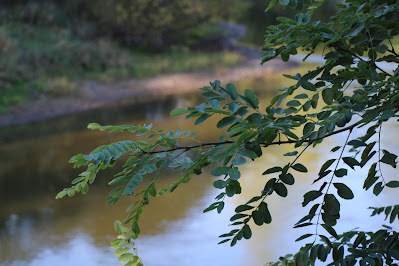It’s mid-morning as I stand on the Barry Rd bridge to watch the water of the Bad River flow slowly under me. The name of this 44-mile watercourse comes from the Chippewa Indians who called the river "maw-tchi-sebe" or quite literally, "bad river," because of how difficult it was to navigate. Current temperatures are in the low 60’s under partly sunny skies and a gusty wind as I turn west and get a brief look at an American Beaver swimming near its partial dam and lodge of mud and piled branches, on the right bank. These lodges are well-insulated and can be 30 degrees warmer than freezing temperatures. Unfortunately, the beaver submerges before I can get a photo. Moving down off the bridge, I begin exploring the nearby floodplain where I come upon a freshly gnawed beaver stump and a well-hidden, 2-inch Leopard Frog. Nearby, I notice Milkweed seeds swaying in the wind, a perching Milkweed Bug and the crimson leaves of a Virginia Creeper vine climbing up a leafless Hawthorn tree. Turning around and crossing to the east side of the bridge, I make my way along a high bank covered with crunchy, fallen leaves. Looking down, I notice the leaf litter contains mostly oak mixed with an evergreen ground cover called Periwinkle. Despite its beautiful purple spring blossoms (stock photo), this non-native plant can spread rapidly and out-compete native species. Moving down closer to the river’s edge, I pause to look and listen as a gust of wind blows a few acorns off an overhanging oak tree into the leaf-covered water. Still on the muddy, shore, I watch the river’s gentle current. From here it flows eastward about 20 miles where it merges with the Shiawassee River, about 2-miles beyond the village of St. Charles. Back up the bank, I look around at a variety of tree trunks, including Wild Cherry, Shagbark Hickory and Hop Hornbeam with a large knot-hole. These holes are often used by insects and small birds like Black-capped Chick-a-dees (stock photo). Nearby, I spot a partially buried deer carcass and a few 2-inch dried, spiny seedpods of Wild Cucumber. Hydrostatic pressure that builds as the seedpods dry may cause them to burst open, flinging the seeds to the ground. (stock photo), occasionally making an audible sound. Looking skyward near the car, I observe the colorful, wind-blown leaves of a mature, Red Oak tree. The range and intensity of these colors are greatly influenced by the weather. The dry, sunny weather we’ve had this fall increased the production of the red pigment, anthocyanin in such leaves.
Autumn breathes a sigh
October breathes its last
Green goes in hiding
Others fading fast
Redwings left the marsh
Most muskrats stayed
Gone the flowered fields
Gone the forest shade
Nature dials down
Calls of creatures wild
No more longer days
No more breezes mild
D. DeGraaf



